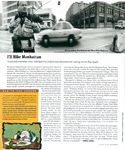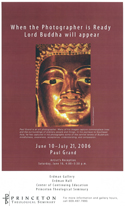About Paul Grand
I am a fine art photographer who has traveled the globe in search of distinctive images. I started in New York by photographing subway stations and brownstones and ended up all the way in Southeast Asia, stopping on the way in countries like Morocco, Switzerland and Turkey. My work has been recognized by a variety of museums and galleries, and media outlets including television, radio, and magazines. But let the media speak for itself. Below are some of my articles and interviews.
Artist's Statement
Pierre Bonnard said, “Few people know how to see, to see well, to see fully.” Or, as Thoreau expressed it, “It's not what you look at that matters, it's what you see.” That is half of my job. The remainder is to see distinctively, even idiosyncratically.
I am an art photographer shooting architecture, portraits, landscapes and abstractions. I have created portfolios around the world. I shoot with a Nikon 35 mm system and use iso 100 negative film. All my images are taken with a tripod.
These images capture, on an elemental level, the commonplace lives and surroundings of ordinary people to suggest a deeper, spiritual level of interconnectedness and shared existence. They serve to awaken questions of humanity, beauty and boundary. The details of my subjects exhibit wonderful combinations of shapes, objects, colors and texture, scarcely suspected on casual observation. They are simple uncommon commonplace subjects that the prospective viewer might easily pass unrecognized. These small, modest fragments synthesize into monumentality.
My style is painterly. I have primarily been influenced by Mark Rothko, Barnett Newman and Milton Avery. At times, the images are sculptural and even a bit theatrical. The subjects are intimate, close portraits, whole or fragments, be they people, buildings or landscapes. Arches, lanes, doors, floors, windows and walls suggest states of transition. Reflections expose a parallel universe, neither obvious nor expected. Reality weaves into abstraction and rebounds into reality. Some of my most challenging compositions are painterly abstractions.
The landscape photographer Eliot Porter taught me intimacy. I avoid the big picture and focus instead on the telling detail. My interest and perception lies in the smaller mosaics of a few isolated parts of a larger vastness, yielding sharper, clearer images and understandings. The core details are seminal because I believe that the component parts are greater than their summation into the whole. The results give vivid life to overlooked fragments and yield unexpected recognition of the small, forgotten and unseen subjects and moments that enrich our lives.
The Japanese aesthetic has a saying wabi-sabi that illuminates a set of ancient ideals that include wabi (transient and stark beauty), sabi (the beauty of natural patina and aging) and yugen (profound grace and subtlety.) It requires a conscience, mindful approach to everyday life as it reflects the beauty of things imperfect, impermanent and incomplete. Words like flaws, crooked, chipped, distressed, rusty, plain, humbled and weathered describe it. It is underplayed and modest, a kind of quiet undeclared beauty that waits to be discovered.
I have had five major solo shows since 2006 and two recently. I have received three awards for entries in juried museum shows since 2005. One of these submissions was reviewed as a “luminous masterpiece.” I have been featured in Outside magazine, Time Out New York and on Fox News and National Public Radio. I had a substantial retrospective show at the Trenton Museum From September to November, 2009. My most recent solo show was at the Michener Museum, Doylestown, PA, October 2015 to February 2016.
Over 350 of my images are beautifully displayed and housed in my home. I only sell directly or though interior designers. I occasionally open my home to host charitable events.
In a previous incarnation, I took my Ph. D. in synthetic organic chemistry at Cal Tech and was awarded two fellowships. I retired from the Colgate-Palmolive Company at the age of 46. My two last positions there were R&D Director and Vice President of its Venture Company. Between Colgate and photography, I continue to spend a considerable amount of time mountain climbing, hiking, and snowshoeing in Switzerland.
Throughout my career, I have been blessed to work with two outstanding printers. Julio Melendez primarily did my chemical darkroom printing, while Ken Bledsoe worked on all of my digital images. With Ken's help, I grew to understand the breadth and depth of creative transformations that digital techniques can offer.
Television Interview
National Public Radio Interview
John Thornton: Photography Beyond the Surface






